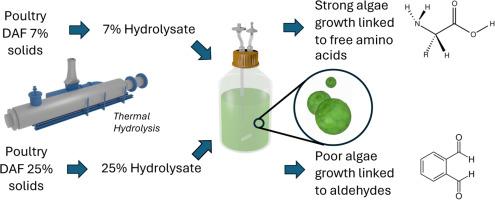Chemical factors governing growth of nutraceutical Chlorella sorokiniana on thermal hydrolysate of poultry processing waste
IF 7.1
Q1 ENGINEERING, CHEMICAL
引用次数: 0
Abstract
The growing poultry processing industry generates large quantities of meat byproducts and wastes. Many of these wastes are currently land applied because they contain high water content, leading to putrid odors that impact nearby communities. Herein, we developed a process to valorize this waste: thermal hydrolysis followed by cultivation of nutraceutical Chlorella on the resulting aqueous phase. We investigated the impact of two solids loading levels (7% and 25% w/v) into thermal hydrolysis and their respective impacts on downstream Chlorella growth and toxicity. It was found that solids loading was a powerful governing factor in the growth of Chlorella: lower solids loading (7%¦w/v) led to robust algae growth without hydrolysate dilution (>2.2 g/L in 4 days) while higher solids loading (25%¦w/v) led to complete growth inhibition that could not be undone with eightfold dilution. Because high solids loading is economically attractive, non-targeted LC/MS-MS and dose-response assays were used to identify molecules that likely contributed to toxicity. Aldehydes, such as phthalaldehyde, present at 1.9 mg/L in the 25% hydrolysate, were identified for the first time in aqueous phase and found to contribute to the observed toxicity. This work makes important progress in our understanding of chemical toxicity in hydrothermally treated aqueous phases and establishes solids loading as a major governing parameter.

控制营养小球藻在家禽加工废弃物热水解物上生长的化学因素
不断发展的家禽加工业产生了大量的肉类副产品和废物。这些废物中有许多目前是土地应用,因为它们含有高含水量,导致腐烂的气味,影响附近的社区。在这里,我们开发了一种工艺来评估这种废物:热水解,然后在得到的水相上培养营养小球藻。我们研究了两种固体负载水平(7%和25% w/v)对热水解的影响,以及它们各自对下游小球藻生长和毒性的影响。研究发现,固体负载是小球藻生长的一个重要控制因素:低固体负载(7% μ w/v)导致藻类在没有水解物稀释的情况下生长旺盛(4天内达到2.2 g/L),而高固体负载(25% μ w/v)导致生长完全抑制,即使稀释8倍也无法消除。由于高固体负载在经济上具有吸引力,因此使用非靶向LC/MS-MS和剂量反应试验来鉴定可能导致毒性的分子。醛类物质,如邻苯二醛,在25%的水解液中以1.9 mg/L的浓度存在,首次在水相中被发现,并被发现有助于观察到的毒性。这项工作使我们对水热处理水相的化学毒性的理解取得了重要进展,并建立了固体载荷作为主要的控制参数。
本文章由计算机程序翻译,如有差异,请以英文原文为准。
求助全文
约1分钟内获得全文
求助全文
来源期刊

Chemical Engineering Journal Advances
Engineering-Industrial and Manufacturing Engineering
CiteScore
8.30
自引率
0.00%
发文量
213
审稿时长
26 days
 求助内容:
求助内容: 应助结果提醒方式:
应助结果提醒方式:


